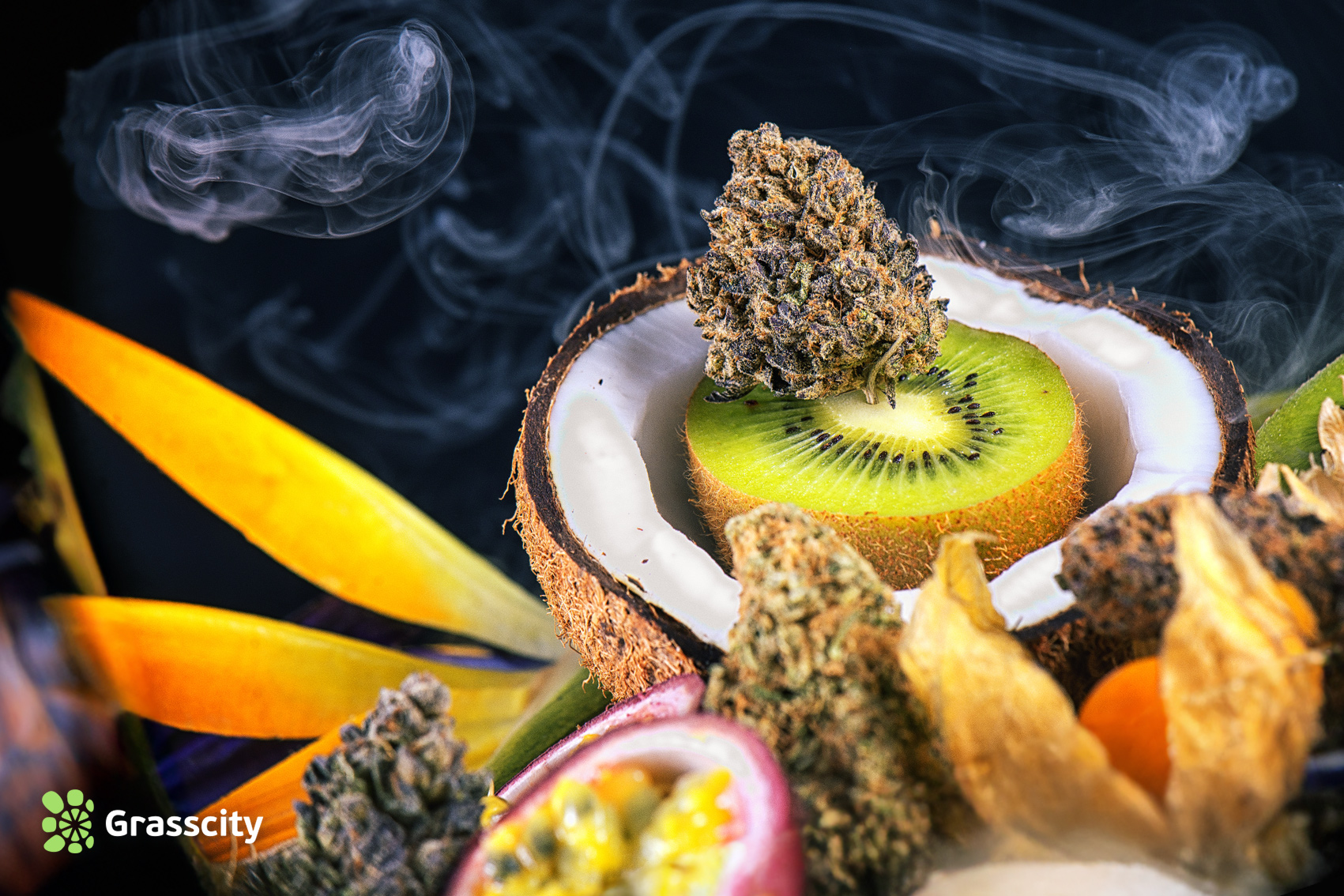
Have you ever wondered what makes a lemon smell citrusy and why some of your weed seems to share the same smell? If it's all THC, then how come different strains act, taste, and smell differently?
The answer: terpenes.
These aromatic compounds are popular in cannabis products. Still, you can also find them throughout the plant kingdom and even in some insects, playing a vital role in our sensory experience and even interacting with our endocannabinoid system.
From influencing the flavor of our food to offering potential wellness benefits, terpenes are very interesting chemical compounds.
Here's everything you need to know about terpenes and why they are fantastic.
What Are Terpenes?
Terpenes are a large and diverse group of organic compounds found in plants and some animals. They are the building blocks for many other natural products, like essential oils, and are responsible for the distinct aromas and flavors of most plants.
Chemically, terpenes are unsaturated hydrocarbons, meaning they contain carbon and hydrogen atoms and have double bonds between some carbon atoms. Their basic formula is (C5H8)n, where n is an integer greater than or equal to 2. This formula can be simplified to C10H16, which represents the building block isoprene. Terpenes are formed by linking together multiple isoprene units in various combinations.
The biogenetic isoprene rule states that most terpenes are biosynthesized from the five-carbon molecule isoprene. This "rule" isn't absolute but helps explain the structural similarities and diversity observed in terpenes. By combining and modifying isoprene units, plants like cannabis can create flowers packed with a vast array of terpenes, all with unique properties.
Types and Examples of Terpenes
Here are some common terpenes, their sources, and their distinctive properties:
Pinene
Sources: Pine trees, rosemary, sage, coniferous forests
Properties: Fresh, piney, woody scent
Pinene is one of the most abundant terpenes found in nature. It contributes to the characteristic smell of pine forests and is also present in many herbs and spices. Pinene has been shown to have anti-inflammatory and bronchodilatory properties, potentially explaining its use in herbal remedies for respiratory wellness.
Limonene
Sources: Citrus fruits (lemon, orange, lime), grapefruit, peels of citrus fruits
Properties: Citrusy, lemony, uplifting scent
Limonene is another widely occurring terpene responsible for the citrusy aroma of many fruits and cannabis strains. It has also been linked to potential anti-inflammatory and anti-cancer properties, although further research is needed.
Myrcene
Sources: Mangoes, hops, lemongrass, thyme
Properties: Earthy, musky, herbal scent
Myrcene is characterized by its earthy, musky, and slightly spicy scent, often described as a complex combination of hints of cloves, lemongrass, or even a diesel-like quality.
Linalool
Sources: Lavender, mint, coriander, citrus fruits
Properties: Floral, lavender, citrusy scent
Linalool is found in lavender and is traditionally used for its calming and sleep-promoting effects. Linalool is also present in some citrus fruits and herbs and may contribute to their characteristic aromas.
Caryophyllene
Sources: Black pepper, cloves, rosemary, oregano
Properties: Spicy, peppery, woody scent
Caryophyllene is a unique terpene because it is the only terpene known to interact directly with the human endocannabinoid system, which regulates various physiological processes, including pain, inflammation, mood, and appetite. Caryophyllene's potential wellness effects are being actively studied.
Terpinolene
Sources: Limes, apples, pine trees, hops
Properties: Floral, lime-like, piney scent
Terpinolene is a terpene known for its diverse aroma, ranging from floral and lime-like to piney. It may have potential mood-boosting and energizing effects, as well as potential anti-inflammatory and antibacterial properties.
Potential Benefits of Terpenes
Terpenes are being studied for their potential health benefits, including reducing anxiety, improving mood, and alleviating pain. Dabbing enthusiasts often look for terpene-rich resins and concentrates for their distinctive flavors and potential effects. The "entourage effect" suggests that terpenes and cannabinoids (like THC and CBD) may work together to produce enhanced overall effects.
While research on terpenes is still ongoing, there's promising evidence suggesting they offer a range of potential health benefits, including:
- Improved Mood and Relaxation: Certain terpenes, like limonene and linalool, have been shown to promote feelings of calmness and well-being. Inhaling essential oils containing these terpenes or consuming products infused with them may have some anti-anxiety and antidepressant effects.
- Pain Relief: Some terpenes, such as pinene and beta-caryophyllene, exhibit some analgesic and anti-inflammatory effects. These terpenes may help manage pain associated with conditions like arthritis or headaches.
- Sleep Support: Terpenes like myrcene are known for their sedative effects and may aid in relaxation and sleep quality. Aromatherapy with essential oils containing myrcene or consuming products formulated with it could potentially improve sleep.
- Cognitive Function: Early research suggests that some terpenes may have neuroprotective properties and could positively impact memory and focus. Limonene, for example, has shown promise in improving cognitive function in animal studies.
While the potential benefits of terpenes are promising, it's important to remember that we still need to do a lot more research to fully understand their effects and mechanisms of action in the human body.
Until then, terpenes are not a cure for any medical condition and should not be used as a substitute for professional medical advice.
Terpenes in Everyday Life
Terpenes are everywhere in our daily lives. You can find them in a wide variety of plants, helping define their scent, flavor, and even their defense mechanisms.
Here are some places where you can find terpenes safe for human consumption:
- Food and Beverages: Many fruits and vegetables, like citrus fruits, mangoes, and broccoli, contain terpenes that contribute to their characteristic flavors and aromas. Even some spices, like pepper and cinnamon, get their unique taste from terpenes.
- Essential Oils: Terpenes are the main components of essential oils, which are extracted from plants and used in aromatherapy. Lavender oil, for example, is known for its relaxing properties due to the presence of linalool, a terpene with calming effects.
- Cleaning Products: Some cleaning products contain terpenes derived from natural sources such as pine needles or citrus peels. Some terpenes can act as antimicrobial and disinfectant agents, making them ideal for cleaning products.
- Perfumes and Cosmetics: Due to their aromatic properties, some terpenes are widely used in the fragrance industry to create perfumes, colognes, and other scented products. They can also be found in cosmetics such as lotions and soaps, adding a pleasant scent and sometimes even having beneficial properties for the skin.
- Cannabis Plant: The Cannabis Sativa plant produces flowers that are rich in multiple types of terpenes and cannabinoids like cannabidiol and tetrahydrocannabinol. Different strains share different terpene profiles, giving them their unique and distinctive features that can interact and enhance the psychoactive effects of THC.
Overall, terpenes are an interesting group of natural compounds that play a significant role in the natural world and have various uses and properties. As we keep researching terpenes, we will keep finding new and better ways of using them in our everyday lives.
The Role of Terpenes in Cannabis
Terpenes play a crucial role in the world of cannabis, influencing the flavor, effects, and overall experience.
Terpenes are mainly what give different strains their distinctive aromas and flavors. Each terpene has its unique scent profile, and the specific combination of terpenes present in a particular strain will define its overall fragrance and taste. For example, if you've ever smelt citrusy notes in your medical cannabis, you may have been smelling limonene, while myrcene has an earthy, musky aroma.
While THC is the primary psychoactive compound in cannabis, terpenes are believed to interact with and modulate the effects of THC and other cannabinoids through a phenomenon called the "entourage effect." It proposes that the various compounds in cannabis, including terpenes, cannabinoids, and other minor components, work together to produce the overall effects experienced by a user. This synergy is why vaping or consuming isolated cannabinoids produces different effects than full-spectrum alternatives.
For example, myrcene, known for its relaxing properties, may enhance the sedative effects of THC related to some Indica strains. In contrast, limonene, with its potential uplifting effects, may counteract some of the anxiety-inducing effects of THC. While research on the entourage effect is everything but conclusive, it suggests that terpenes are the reason behind the main differences in effects between strains.
Final Thoughts
As we've seen, terpenes are fascinating compounds with promising potential effects. As research continues, we're sure we'll keep finding new properties and potential uses for them. For now, we're sure thankful for the pleasant tastes, aromas, and effects they've given us!
Terpenes: FAQs
Here are the answers to common questions on terpenes:
What makes terpenes essential in aromatherapy?
Terpenes act as the main aromatic compounds of many plants, and they are the primary reason essential oils have distinct smells. When inhaled or absorbed through the skin, these volatile molecules can interact with the olfactory system and potentially influence mood, stress levels, and even some physiological functions.
For example, linalool, found in lavender, is known for its relaxing properties, while limonene, present in citrus peels, may have uplifting and mood-boosting effects. However, it's important to note that the research on the therapeutic effects of aromatherapy is still ongoing, and more studies are needed to fully understand how terpenes work and how to best use them.
How do terpenes affect the flavor and aroma of cannabis?
Terpenes are vital in shaping the unique aroma and flavor profiles of different cannabis strains. Each terpene has its distinct scent profile, and the specific combination of terpenes present in a particular strain determines its overall fragrance and taste.
Can terpenes be found in food?
Yes. Terpenes are naturally present in a wide variety of fruits, vegetables, herbs, and spices and are responsible for their unique aromas and flavors.
Here are some examples of edible plants and the terpenes they're rich in:
- Citrus fruits (limonene)
- Lavender (linalool)
- Rosemary (alpha-pinene)
- Hops (humulene)
- Geraniums (geraniol)
- Black pepper (beta-caryophyllene)
These terpenes contribute not only to the taste and smell of food but may also play a role in the nutritional value and antioxidant properties of certain foods.
Are terpenes used in any industrial applications?
Yes, terpenes have various applications beyond their roles in aromatherapy and food. They are used in a range of industrial settings, including:
- Fragrances and cosmetics: Terpenes are used to create perfumes, colognes, and various personal care products due to their pleasant and diverse aromas.
- Flavoring agents: Specific terpenes are used in the food and beverage industry to enhance or modify the flavor profiles of products.
- Solvents and cleaning agents: Some terpenes have solvent and antifungal properties and can be used in cleaning products for various applications.
- Biofuels: Research is ongoing exploring the potential of terpenes as a renewable source of biofuels.
As research continues to explore the diverse properties and potential applications of terpenes, their role in various fields is likely to continue expanding.
